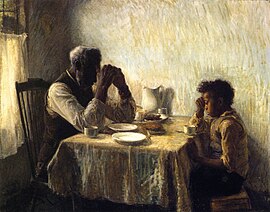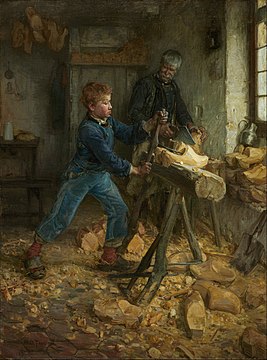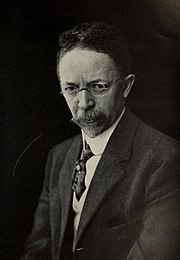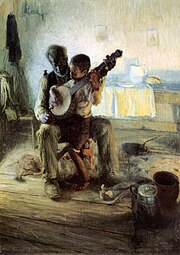
African-American art is a broad term describing visual art created by African Americans. The range of art they have created, and are continuing to create, over more than two centuries is as varied as the artists themselves. Some have drawn on cultural traditions in Africa, and other parts of the world, for inspiration. Others have found inspiration in traditional African-American plastic art forms, including basket weaving, pottery, quilting, woodcarving and painting, all of which are sometimes classified as "handicrafts" or "folk art".

Thomas Hovenden was an Irish artist and teacher who spent much of his life in the United States. He painted realistic quiet family scenes and narrative subjects and often depicted African Americans.

Henry Ossawa Tanner was an American artist who spent much of his career in France. He became the first African-American painter to gain international acclaim. Tanner moved to Paris, France, in 1891 to study at the Académie Julian and gained acclaim in French artistic circles. His painting Daniel in the Lions' Den was accepted into the 1896 Salon, the official art exhibition of the Académie des Beaux-Arts in Paris. Tanner's Resurrection of Lazarus was purchased by the French government after winning the third-place medal at the 1897 Salon. In 1923, the French government elected Tanner chevalier of the Legion of Honor.

David C. Driskell was an American artist, scholar and curator; recognized for his work in establishing African-American Art as a distinct field of study. In his lifetime, Driskell was cited as one of the world's leading authorities on the subject of African-American Art. Driskell held the title of Distinguished University Professor of Art, Emeritus, at the University of Maryland, College Park. The David C. Driskell Center at the University of Maryland, is named in his honor.

A sabot is a clog from France or surrounding countries such as The Netherlands, Belgium or Italy. Sabots are either whole-foot clogs or a heavy leather shoe with a wooden sole.
The Camille O. and William H. Cosby Collection of African American Art is a private collection of over sixty pieces of African-American art owned by entertainer Bill Cosby and his wife Camille.

The Young Sabot Maker is an oil-on-canvas painting made by the American artist Henry Ossawa Tanner in 1895. The painting was accepted for the 1895 Paris Salon and was Tanner's second Salon-entered painting.

The Banjo Lesson is an 1893 oil painting by African-American artist Henry Ossawa Tanner. It depicts two African-Americans in a humble domestic setting: an old black man is teaching a young boy – possibly his grandson – to play the banjo.

Charles C. Dawson was an American painter, printmaker, illustrator, and graphic designer.

The Annunciation is an 1898 painting by the African-American painter Henry Ossawa Tanner. It depicts the biblical scene of the Annunciation, where the archangel Gabriel visits Mary to announce that she will give birth to Jesus. The painting is held by the Philadelphia Museum of Art.
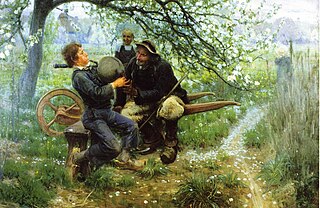
The Bagpipe Lesson is a painting by Henry Ossawa Tanner, completed in late 1893 and displayed at the World's Columbian Exposition and at the Pennsylvania Academy of the Fine Arts 63rd annual exhibition, held from December 18, 1893 to February 24, 1894. The painting was begun by Tanner during his first summer in France, during a trip to Brittany. He finished the work in Philadelphia.

Sarah Elizabeth Tanner was active as a missionary worker and a religious leader in the African Methodist Episcopal Church.

Woman From the West Indies is a painting by Henry Ossawa Tanner painted about 1891 in Brittany, France, during his first or second summer in France. The portrait is unsigned but is attributed to Tanner based on the way it was painted, compared to Tanner's known works from 1891-1893. Those examining the painting looked for patterns in the way the artist used color, the brush strokes, and the stylistic choices in how light itself is shown in the painting.

Salomé is a painting by Henry Ossawa Tanner, showing the princess Salome from the Bible, who danced before her stepfather Herod Antipas, and who demanded the head of John the Baptist as a reward for her performance. Tanner painted Salome as part of his Christian-themed paintings.
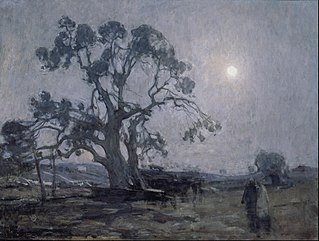
Abraham's Oak is a painting by Henry Ossawa Tanner, an American painter who lived in France, completed about 1905. While Tanner is well known today for two paintings in the United States, The Banjo Lesson and The Thankful Poor, both about African-American families, the bulk of his artwork, including some of his most iconic paintings, were concerned with exploring biblical subjects. Abraham's Oak was supposed to be a place where Abraham pitched his tent and built an alter to God, who had promised the Land of Canaan for him and his children, and where he was visited by an angel.

Flight into Egypt was a painting by Henry Ossawa Tanner, created in Paris about 1899 and displayed at the Carnegie Institute that year, along with Judas. The painting, a religious work, is an example of Tanner's symbolist paintings. The 1899 version was his first version of the painting.

The Resurrection of Lazarus is a painting by Henry Ossawa Tanner entered into the Paris Salon in 1897 and winning a third place medal. During his lifetime, this was the painting for which he was most known, his "masterwork". Since his death in 1937, secular tastes have pushed The Banjo Lesson to the top place in public esteem. The work was purchased by the French government for display in its Luxemburg museum. Today the painting is held by the Musée d'Orsay.

Christ at the home of Mary and Martha is a painting by Henry Ossawa Tanner completed about 1905 and permanently in the collections of the Carnegie Museum of Art in Pittsburgh, Pennsylvania. Tanner spoke of the painting as having been particularly challenging to paint. The painting was purchased in 1907 by the museum. It was also exhibited in Pittsburgh in 1907 and New York in 1908.

Nicodemus Visiting Christ is a painting by Henry Ossawa Tanner, made in Jerusalem in 1899 during the artist's second visit to what was then Palestine. The painting is biblical, featuring Nicodemus talking privately to Christ in the evening, and is an example of Tanner's nocturnal light paintings, in which the world is shown in night light.
